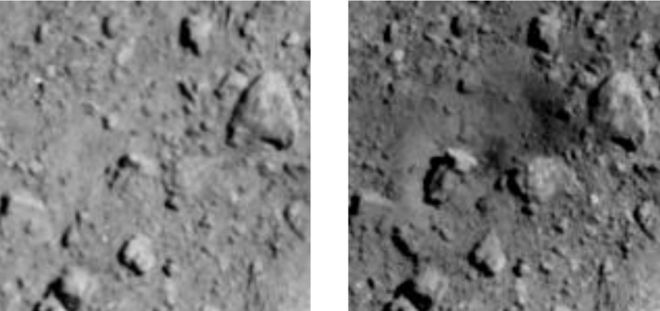The Hayabusa-2 spacecraft has sent back images of the crater made when it detonated an explosive charge on the asteroid it is investigating.

On 5 April, the Japanese probe released a 14kg device packed with plastic explosive on to the asteroid Ryugu.
The device was expected to blow a crater in the surface about 10m wide.
Scientists want to get a “fresh” sample of rock to help them better understand how Earth and the other planets were formed.
Hayabusa-2 has now taken pictures of the area where the “small carry-on impactor” (SCI) device was to have detonated, and identified a dark depression where fresh material has been excavated from beneath the surface.
Scientists working on the Japanese Aerospace Agency (Jaxa) mission said the blast area on the surface measures about 20m in diameter – twice the size of the crater they expected to see.
The mission’s official account tweeted: “We did not expect such a big alternation, so a lively debate has been initiated in the project!”
Because of the debris that would have been thrown up in this event, Hayabusa-2 manoeuvred itself before the detonation to the far side of 800m-wide Ryugu – out of harm’s way and out of sight.
But the probe left a small camera behind called DCAM3 to observe the explosion.
Hayabusa-2 later returned to its “home position” about 20km above the asteroid’s surface. From here, it conducted a search for the crater produced in the explosion.
In coming weeks, scientists will command the probe to descend into the crater to collect its fresh samples.
Because they will come from within the asteroid, they will be less altered by the harsh environment of space.
Bombardment with cosmic radiation over the aeons is thought to change the surfaces of these planetary building blocks.
Ryugu belongs to a particularly primitive type of space rock known as a C-type asteroid. It’s a relic left over from the early days of our Solar System, and therefore records the conditions and chemistry of that time – some 4.5 billion years ago.

